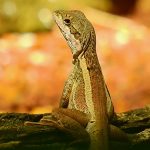LONG NOSED TA-TA DRAGON
Long-nosed Ta-ta Lizard
Key Features
| Feature | Details |
|---|---|
| Size | 25 cm (including tail) |
| Distinctive | Elongated snout; earthy brown and grey camouflage |
| Habitat | Arid/semi-arid regions; central and western Australia; open woodlands, shrublands, grasslands |
| Adaptations | Fast runner—often on hind legs; arm-waving “ta-ta” display for cooling and communication |
Life in the Wild
- Habitat: Found across Australia’s dry heartlands, often basking on sun-warmed rocks.
- Locomotion: Not just a sprinter—these lizards have been caught running on their back legs à la mini-dinosaur!
- Lifespan: Several years in the wild (though precise figures vary due to environmental factors and predation).
Diet and Ecological Role
- Food: Primarily insectivorous, feasting on insects and arthropods.
- Benefit: Helps keep insect populations in check—doing their ecological bit like tiny pest control agents.
Breeding and Reproduction
- Season: Warmer months.
- Eggs: Females lay clutches in secure burrows or under rocks.
- Hatchlings: Emerge after several weeks, miniature versions ready to scamper.
Communication & Behaviour
- Vocalisations: Silent by nature—
- Body Language: Famous for the “ta-ta” wave—a raised forelimb signal, which:
- Communicates with other lizards (possibly territorial or social cues)
- Helps regulate body temperature (lifting limbs off hot surfaces)
Cultural Significance
- Indigenous Culture: Features in stories and artworks, underscoring a deep connection between people and the land.
Conservation Status
- Current Status: Not endangered.
- Potential Threats: Habitat loss, climate change (as with so much of Australia’s unique fauna).
Fun Fact
Did you know? The “ta-ta” in their name comes straight from their limb-waving gesture, which looks like the lizard is bidding you a polite farewell.







